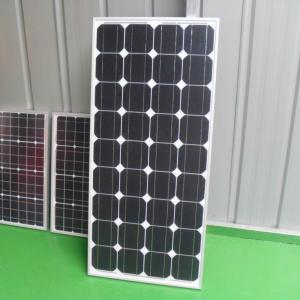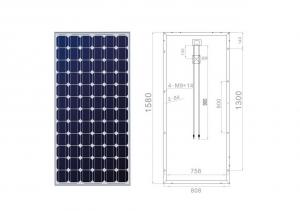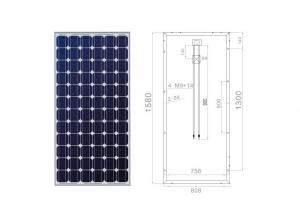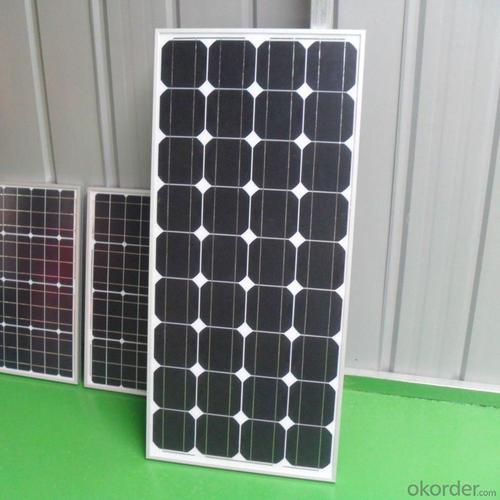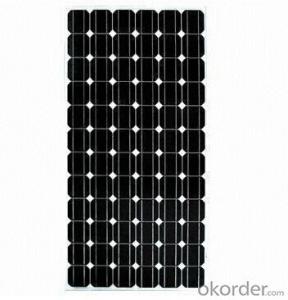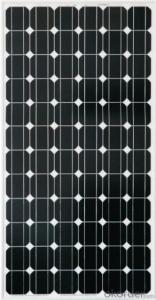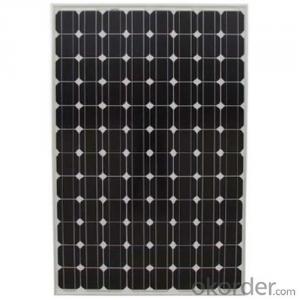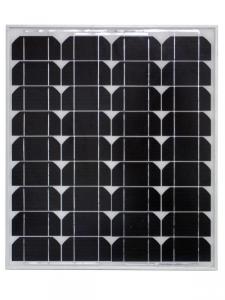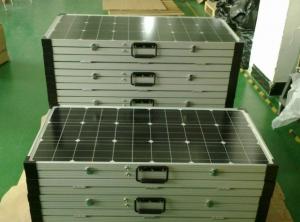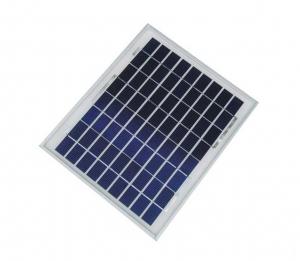Solar Panels for Sheds Kits - Solar Monocrystalline (210W-225W)
- Loading Port:
- Shanghai
- Payment Terms:
- TT
- Min Order Qty:
- 1 pcs pc
- Supply Capability:
- 100000/month pc/month
OKorder Service Pledge
OKorder Financial Service
You Might Also Like
Solar Monocrystalline (210W-225W)
Introduction of Solar Monocrystalline (210W-225W)
Solar modules use light energy (photons) from the sun to generate electricity through the photovoltaic effect. The majority of modules use wafer-based crystalline silicon cells or thin-film cells based on cadmium telluride or silicon. The structural (load carrying) member of a module can either be the top layer or the back layer. Cells must also be protected from mechanical damage and moisture. Most solar modules are rigid, but semi-flexible ones are available, based on thin-film cells. These early solar modules were first used in space in 1958.
CNBM Solar photovoltaic (PV) Panel is designed for large electrical power requirements. It is the optimal choice for both on-grid and off-grid power systems. CNBM Solar panel offers high performance of power per square foot of solar array. Monocrystalline silicon(c-Si): often made using the Czochralski process. Single-crystal wafer cells tend to be expensive, and because they are cut from cylindrical ingots, do not completely cover a square solar cell module without a substantial waste of refined silicon. Hence most c-Si panels have uncovered gaps at the four corners of the cells.
Characteristics of Solar Monocrystalline (210W-225W)
I. Solar Cell : High efficiency crystalline solar cell. Even if under the weak light, the solar module can produce maximum power output.
II. Tempered glass (toughened glass): Anti-reflecting coating and high transmission rate glass increase the power output and mechanical strength of solar module.
III. EVA and TPT: Using high quality EVA and TPT to prevent destroying and water.
IV. AI frame: Without screw, corner connection. 6 holes on the frame can be installed easily.
V. Junction box: Multi function junction box with water proof.
VI. Long lifetime: ≥25 years; Less power decrease.
VII. Good performance of preventing from atrocious weather such as wind and hails.
VIII. Resisting moisture and etching effectively, not effected by geology.
IX. The certificate issued by international authority: UL, TUV, IEC, VDE, CE.
Standard Test Conditions of Solar Monocrystalline (210W-225W)
The opto-electrical specifications shown below are stabilized values being measured at Standard Test Conditions, Irradiance: 1000W/m2, Spectrum: AM1.5 at 25°C, The info below is subject to manufacturing tolerances. Where appropriate minutes of measurement are available and are used for the dimensioning of the installation.
Advantages of Solar Monocrystalline (210W-225W)
• CNBM Solar performance guarantees for 25 years
• 10 years guarantee for workmanship
• Timeliness of delivery
• Quality Products certified (TÜV, UL, CE, VDE, ISO)
CNBM International Corporation's products including Monocrystalline Solar Panel, Polycrystalline Solar Panel have received and enjoyed famous reputation in many countries and regions in the world .As a solar panel manufacturer in China, we strive to provide our customers with excellent service, superior products and unmatched value.
Technical Data of Solar Monocrystalline (210W-225W)
Max Power Voltage Vmp (V) | 27.6V | 27.9V | 28.2V |
Max Power Current Imp (A) | 7.6A | 7.7A | 7.8A |
Open Circuit Voltage Voc (V) | 33V | 33.3V | 33.7V |
Short Circuit Current Isc (A) | 8.48A | 8.61A | 8.71A |
Max Power Pm (W) | 210W | 215W | 220W |
Temperature Coefficient of Cells
NOCT | 47℃±2℃ |
Temperature Coefficients of Isc (%/℃) | 0.0492 |
Temperature Coefficients of Voc (%/℃) | -0.3374 |
Temperature Coefficients of Pmp (%/℃) | -0.4677 |
Mechanical Data of Solar Monocrystalline (210W-225W)
Dimension | 1482×992×40mm |
Weight | 17kg |
Tolerance | 0~+5W |
The dimension of the modules can be changed according to the demand of clients
Limits of Solar Monocrystalline (210W-225W)
Operating Temperature | –40 °C to +85°C |
Storage Temperature | –40 °C to +85°C |
Max System Voltage | 1000VDC(IEC)/600VDC(UL) |
Guarantee of Solar Monocrystalline (210W-225W)
Products Guarantee | 10 yrs free from defects in materials and workmanship |
Performance Guarantee | No less than 90% within 10yrs and no less than 80% within 20yrs |
Certificates | IEC, ISO, TUV, CE |
The Application of Solar Monocrystalline (210W-225W)

The Pakage of Solar Monocrystalline (210W-225W)

- Q: I want to install a solar panel on my car. I want to know that how much energy can be generated by a panel of size 4 foot by 6 foot. and the cost of installation.
- A little more than 0 watts per square foot, so that size panel would generate 250 watts under ideal conditions, which is noon on a sunny but not too hot day, near the equator. That's about /3 horsepower, or the same power as a man working hard. That is larger than needed to keep the battery of the car charged, unless you plan to run a laptop or something off it at night. The power is also too small to power the car for driving. If it's an electric car, you could get maybe another 2 miles per day out of the car, again, under ideal conditions. An RV store might have an idea of how much installation would cost. They would be accustomed to solar panels for RV's, but probably not small cars. A panel of that size would cost perhaps $500-800 just for the panel.
- Q: What is the impact of snow accumulation on solar panels' performance?
- Snow accumulation on solar panels can have a significant impact on their performance. When snow covers the panels, it blocks sunlight from reaching the photovoltaic cells, reducing their ability to generate electricity. Additionally, the weight of the snow can put stress on the panels and potentially damage them. However, some modern solar panels are designed with anti-reflective coatings and tilted surfaces to minimize snow accumulation and aid in self-cleaning. In regions with heavy snowfall, regular cleaning or snow removal may be necessary to maintain optimal solar panel performance.
- Q: How much would solar panels cost for: A Cell phoneA average houseA car
- They would cost quite a bit but the user would likely be eligible for some energy credits from the power company and their cell phone carrier which would bring down the costs
- Q: Can solar panels be used on boats or marine applications?
- Yes, solar panels can be used on boats and marine applications. They are a sustainable and efficient way to generate electricity, especially in areas with ample sunlight. Solar panels can be easily installed on the deck or roof of a boat, providing power for various onboard systems such as lighting, navigation equipment, and charging batteries. Additionally, solar panels help reduce reliance on fossil fuels and minimize the carbon footprint of marine activities.
- Q: What controllers and all that stuff do I need for these solar panels. Oh and the the batteries will be rigged up to a big electric motor so please leave information on how to wire the batteries to the motor...THANKS!!! 0 POINTS!
- Many solar panels wired in parallel, 2 volt solar regulator, 2 volt battery e.g. 30 Ah, 240 volt inverter, autotransformer that can go down to 50 volts. There are many parameter to the electric motor missing. AC or DC, current needs for full load. How many watts the motor uses and the number of hours required will influence the solar panel, regulator and inverter specifications.
- Q: how big of an solar panel do i need to power/charge my laptop?would one from canadian tire sell the right one?
- Yes. Basically, here's what you need (I'm keeping this general on purpose): The panels themselves -- how large an area depends on average power consumption and how much power you can get on average. That, in turn , depends on climate. You'd need more in Seattle than Tuscon, for example. I'd guess something in the neighborhod of 0 square feet. Depends also on haow many gadgets (printers, etc.) you have. You'll need a power storage system. Lithium gives you the best poser density (of off-the-shelf stuff) but an ordinary car battery works well and is reliable. And, of course, a control system to manage the power generation/storage/use so everything works together without that annoying smell that tells you you just cooked a few hundred bucks worth of equuipment! :)
- Q: Can solar panels be used in areas with high levels of electromagnetic interference?
- Yes, solar panels can be used in areas with high levels of electromagnetic interference. However, proper precautions and shielding techniques need to be implemented to minimize any potential impact on the performance of the solar panels.
- Q: Can solar panels be used in areas with high levels of saltwater exposure?
- Yes, solar panels can be used in areas with high levels of saltwater exposure. However, it is important to take certain precautions to prevent corrosion and maximize their performance. This can be achieved by using materials that are resistant to saltwater corrosion, such as stainless steel or aluminum frames, and encapsulating the solar cells with durable and protective coatings. Regular maintenance and cleaning can also help ensure the longevity and efficiency of solar panels in such environments.
- Q: Can solar panels be installed on a community center or social gathering place?
- Yes, solar panels can certainly be installed on a community center or social gathering place. In fact, these locations are ideal for solar panel installation as they often have large roof spaces that can accommodate a significant number of panels. Solar energy can help power the community center, reducing electricity costs and environmental impact, while also setting a positive example for the community in terms of sustainability and renewable energy.
- Q: How could I find out what the amp output of a solar panel? Specifically, I want to know how many milliamps can the solar panel on a Casio fx-260 put out?
- You need full sunshine from the sun, or a lamp that will give a light spectrum similar to the sun, a volt meter, Milli-amp meter, and a variable resistor of 0 to 000 ohms. The voltmeter test leads go across the solar cell leads. The amp meter leads will be in series with the solar cell. Let's say, positive lead of the solar cell to the the positive lead of the amp meter, the negative lead of the amp meter to one terminal of the variable resistor, and the wiper terminal of the variable resistor to the negative lead of the solar cell. Slowly decrease the value of the resistor until the voltage from the solar cell just begins to drop. Take note of the amp meter reading. This is about the high end range of the solar cell. You might want to begin with a micro-amp meter for the current meter.
Send your message to us
Solar Panels for Sheds Kits - Solar Monocrystalline (210W-225W)
- Loading Port:
- Shanghai
- Payment Terms:
- TT
- Min Order Qty:
- 1 pcs pc
- Supply Capability:
- 100000/month pc/month
OKorder Service Pledge
OKorder Financial Service
Similar products
Hot products
Hot Searches
Related keywords
